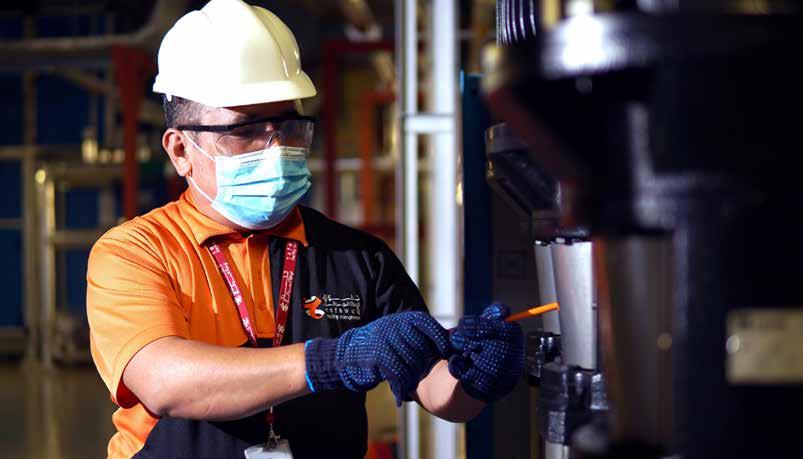
5 minute read
ENERGY
DECARBONIZATION
GE Gas Power explores the role of gas in MENA’s energy future
MENA’s population is projected to continue to grow faster than the global average for the foreseeable future - from over 448 million in 2018 to more than 719 million in 2050. Some countries in the region, such as Iraq, are recovering from prolonged periods of conflict, while more mature economies like those in the Gulf Co operation Council (GCC) are diversifying their industrial base.
“As they look to grow and develop further, governments across the region are exploring opportunities to strength en public infrastructure and trying to balance the growing need for reliable power against climate change concerns and sustainability goals. Consequently, MENA’s energy landscape is under going a grand transformation,” said Joseph Anis, President & CEO of GE Gas Power Middle East, North Africa and South Asia.
THE EVOLVING ENERGY LANDSCAPE
GE and external analysts predict that as renewable energy becomes more affordable, it will be the fastest growing segment in MENA, and in the overall global energy mix. In the UAE, for ex ample, the Energy Strategy 2050 targets an energy mix that includes 44 percent clean energy, while Kuwait has set the target to supply 15 percent of peak electricity demand from renewable energy sources by 2030. As little as a decade ago, such aggressive alternative energy targets from the world’s leading oil and gas producers would have been almost unimaginable.
It is understood that flexible thermal generation, however, will continue
to play a critical but changing role, accounting for up to 60 percent of power generated globally through 2028. The most significant trend in global power generation is the pro jected decline in the use of coal, while gas continues to grow, expecting to account for over one-fifth of total power generated by 2028.
THE ROLE OF GAS IN DECARBONIZING THE ENERGY SECTOR
There are three core elements to a sustainable grid: cost, reliability, and environmental impact. Gas is expected to play a strong role in the future en ergy mix as it can help decarbonize the power sector at affordable costs, while providing access to uninterrupted, dependable power.
Natural gas is more accessible and affordable than ever before. Twenty countries around the world have built liquefication capacity, while more than 35 countries have regasification capacity. There are currently more than 800 million tons per annum (MTPA) of regasification capacity and over 390 MTPA of liquefaction capacity globally. Efficiency and output improvements in gas-fueled power generation technolo gies have complemented the increased availability of gas.
For example, GE’s HA gas turbine technology is now available at over 64 percent combined-cycle (CC) efficiency and is closing in on 65 percent– a feat once considered to be almost impossible.
Switching from coal and oil-based power generation to a mix of gas and renewable energy offers a clear path to decarbonization without compromising the reliability of electricity supply. Re newable energy is typically intermittent in nature as sunshine, rain, and wind speeds vary over the course of a day, as well as across seasons. While that energy can be stored, battery storage solutions remain expensive, often mak ing them economically infeasible when required at a large scale. It costs ~$200

to store one barrel of oil equivalent (BOE) of energy with battery storage solutions. Conversely, storing one bar rel of oil or natural gas at scale is ~$1.
Additionally, electricity typically cannot be cost-effectively stored in large quantities for extended periods of time. For example, a battery with 1 MW of power capacity and 4 megawatt hours (MWh) of usable energy capacity will usually have a storage duration of four hours. This is another reason battery storage can be useful but is not as reliable and feasible as natural gas in complementing renewables. Stated another way, battery technology today and for the foreseeable future is economical in certain locations and only for short durations. It is natural gas complementing renewables then that provides truly reliable and cost-effective energy whenever needed - intra-day, and across days, weeks, and seasons.
GAS POWER TECHNOLOGIES THAT CAN SUPPORT A LOWER-CARBON FUTURE
Driving the era of gas forward are advanced solutions that can enhance the performance of existing energy infrastructure and technologies that can push the efficiency levels of new power generation facilities to unprec edented levels.
New power plants can be set up with gas turbines that offer much higher lev els of efficiency than ever before. For example, GE’s HA gas turbines have helped deliver two world records - one for powering the world’s most effi cient combined cycle power plant, by achieving 63.08 percent gross efficiency at Chubu Electric Nishi-Nagoya Power Plant Block-1 in Japan and the second, for enabling EDF’s Bouchain Power Plant to achieve 62.22 percent net combined cycle efficiency in France. It is the world’s fastest growing fleet of heavy-duty gas turbines with more than 100 units ordered by over 40 customers in 18 countries.
This includes three units ordered by the Sharjah Electricity and Water Au thority (SEWA) for an upcoming 1,800 MW independent combined cycle power project located in Hamriyah. Using three GE 9HA units in com bined cycle operations can help SEWA reduce carbon dioxide emissions by up to 4 million tons per year, com pared to current levels. Impressively enough, this is the equivalent of taking 1 million cars off the UAE’s roads. Capable of ramping up or down at up to 88 megawatts per minute while still meeting emissions requirements, the turbine can also support countries transition to a larger proportion of re newable power in their energy mix by helping to balance grid instability.
Today, we can also adapt gas tur bines to burn clean resources such as hydrogen. GE has more than 75 gas turbines operating on high hydrogen and other related low heating value fuels, including blends of hydrogen and natural gas. These units have now accumulated over 6 million operating hours. GE’s B and E-class gas turbines also have the capability to operate on 100 percent hydrogen with the installa tion of the appropriate combustion and accessory systems.









